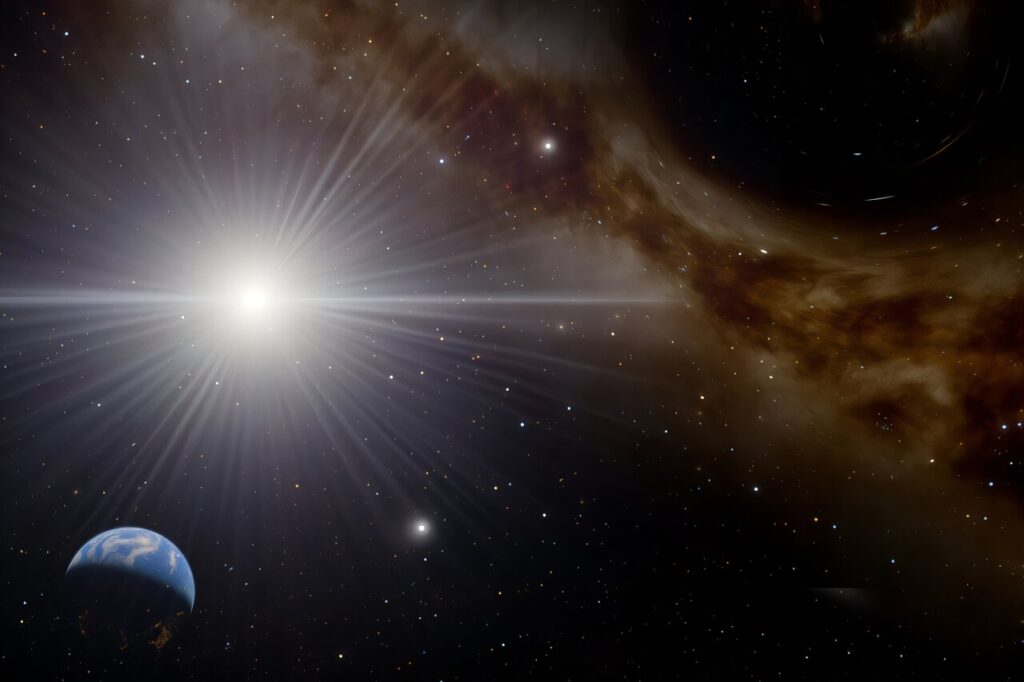
The last remnants of a primordial black hole might be responsible for the highest-energy “ghost particle” ever detected, according to a groundbreaking study by MIT physicists. Published today in Physical Review Letters, the research suggests that a recently observed, highly energetic neutrino could have originated from a primordial black hole explosion just outside our solar system.
Neutrinos, often dubbed “ghost particles” due to their elusive nature, are the universe’s most abundant particle type, yet they rarely interact with matter. Recently, scientists detected a neutrino with unprecedented energy levels, but its source remains unidentified. The MIT team posits that this mysterious neutrino might result from the explosive demise of a primordial black hole.
Understanding Primordial Black Holes
Primordial black holes (PBHs) are theoretical entities, hypothesized as microscopic versions of the massive black holes found at galactic centers. Formed shortly after the Big Bang, some scientists speculate that PBHs could constitute a significant portion of the universe’s dark matter. Like their larger counterparts, PBHs are thought to emit Hawking radiation, a process predicted by Stephen Hawking, causing them to lose energy and eventually explode.
The MIT researchers calculate that if PBHs are indeed the main component of dark matter, a small number of them would be experiencing final explosions in the Milky Way today. Such an explosion could release a burst of high-energy particles, including neutrinos, potentially detectable on Earth.
Detecting the Ghost Particle
The detection of the highest-energy neutrino to date was reported by the Cubic Kilometer Neutrino Telescope (KM3NeT) in February. This underwater detector, located in the Mediterranean Sea, is designed to filter out particles other than neutrinos. It recorded a neutrino with energy exceeding 100 peta-electron-volts, far beyond human capabilities to accelerate particles.
“This is an incredibly high energy, far beyond anything humans are capable of accelerating particles up to,” said Alexandra Klipfel, the study’s lead author.
Similar high-energy neutrinos, though not as extreme, have been detected by the IceCube Observatory at the South Pole. These findings suggest a plausible rate of neutrino impacts on Earth, yet the ultra-high-energy neutrino from KM3NeT remains an anomaly.
Linking Neutrinos to Primordial Black Holes
Intrigued by the possibility that a PBH could produce both the KM3NeT neutrino and those observed by IceCube, MIT physicists Alexandra Klipfel and David Kaiser explored whether such a scenario could occur if PBHs comprise most of the galaxy’s dark matter. Their calculations suggest that a PBH explosion could indeed account for these high-energy neutrinos.
The researchers determined the number and energy of particles emitted by an exploding black hole, estimating that a black hole smaller than an atom would release a final burst of particles, including about 1020 neutrinos, with energies around 100 peta-electron-volts.
“We don’t have any hope of detecting Hawking radiation from astrophysical black holes,” Klipfel noted. “So if we ever want to see it, the smallest primordial black holes are our best chance.”
Implications and Future Research
The MIT team’s findings suggest that about 1,000 primordial black holes should be exploding per cubic parsec per year in our region of the Milky Way. This explosion rate could explain the IceCube results and suggests that a PBH explosion relatively close to our solar system might have produced the recent KM3NeT event.
“An 8% chance is not terribly high, but it’s well within the range for which we should take such chances seriously,” Kaiser remarked, emphasizing the lack of alternative explanations for the observed neutrino events.
Confirming the existence of PBHs and their role in producing high-energy neutrinos would provide unprecedented evidence for Hawking radiation and offer insights into dark matter’s nature. Future detections of high-energy particles could validate the MIT team’s hypothesis and reshape our understanding of the universe.
As scientists continue to explore these possibilities, the search for nearby PBHs and further neutrino observations will be crucial in unraveling the mysteries of dark matter and the fundamental forces governing the cosmos.







